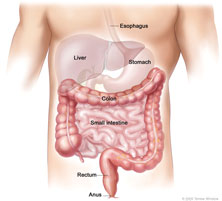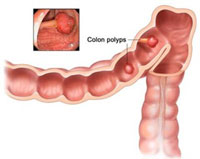Colon And Rectum Cancer

Small Intestine and Colon Anatomy
The small intestine (small bowl) lies between the stomach and the colon. The small intestine is about 20 feet long. Its primary function is to digest and absorb nutrients. It makes up more than 70% of the length and 90% of the surface area of the gastrointestinal (GI) tract. The first 6 feet of the large intestine are called the large bowel or colon. The last 6 inches are the rectum and the anal canal. The anal canal ends at the anus (the opening of the large intestine to the outside of the body.
Small Intestine Cancer Causes
The most common cancerous (malignant) tumors of the small intestine include adenocarcinoma, carcinoid, gastrointestinal stromal tumor, lymphoma, and cancer that have spread from other places in the body.
Small intestine cancer is relatively rare compared to other gastrointestinal malignancies such as gastric cancer (stomach cancer) and colorectal cancer.
Risk factors for small intestine cancer include:
- Crohn's disease
- Celiac disease
- Radiation exposure
- Males are 25% more likely to develop the disease
Risk factors for developing cancer of the small intestine in Crohn's disease include the following:
- Male sex
- Long duration of disease
- Associated fistulous disease: A fistula is an abnormal tube that passes from one surface to another, such as from the colon to the skin.
- Surgical removal of part of the bowel
- The risk of developing small intestinal cancer is six times greater for people with Crohn's disease compared to the general population.
Small Intestine Cancer Symptoms
Like most GI cancers, early symptoms of small intestine cancer tend to be vague and nonspecific. They may include abdominal discomfort associated with the following:
- Nausea
- Bloating
- Loss of appetite
The following symptoms may indicate advanced disease and should be signs to seek medical attention:
- Fatigue
- Weight loss
- Iron deficiency anemia
- Visible blood loss: Blood or a material that looks like coffee grounds may be vomited, or black stools may be passed.
- Severe nausea and vomiting, due to a blockage in the small bowel by the enlarging cancer.
- Jaundice (yellowish skin): This is a symptom in people with cancer that involves the upper small intestine because of blockage of the bile ducts draining the liver.
Small Intestine Cancer Treatment
Surgical removal is the primary treatment for cancer of the small intestine.
- Chemotherapy may be useful if the cancer has spread or is contained but advanced.
- Radiation therapy may be helpful if the disease localized at the place it originated.
- Surgery may also relieve symptoms when the cancer has caused a bowel obstruction. In this case, doctors may perform a bypass procedure or limited tumor removal.
Colon Cancer Causes
Cancer is 50 times more common in the large intestine than in the small intestine. Risk factors for colon cancer include the following:

- Age 50 or older
- A family history of cancer of the colon or rectum
- A personal history of cancer of the colon, rectum, ovary, endometrium, or breast
- A history of Crohn disease
- A history of polyps in the colon
Colon Cancer Symptoms
These and other symptoms may be caused by colon cancer. Other conditions may cause the same symptoms. A doctor should be consulted if any of the following problems occur:
- A change in bowel habits
- Blood (either bright red or very dark) in the stool
- Diarrhea, constipation, or feeling that the bowel does not empty completely
- Stools that are narrower than usual
- Frequent gas pains, bloating, fullness, or cramps
- Weight loss for no known reason
- Feeling very tired
- Vomiting
Colon Cancer Treatment
Surgery is often the main treatment for earlier stage colon cancers.
- Open colectomy: A colectomy (sometimes called a hemicolectomy, partial colectomy, or segmental resection) removes part of the colon, as well as nearby lymph nodes. The surgery is referred to as an open colectomy if it is done through a single incision in the abdomen.
- Laparoscopic-assisted colectomy: This newer approach to removing part of the colon and nearby lymph nodes may be an option for some earlier stage cancers. Instead of making one long incision in the abdomen, the surgeon makes several smaller incisions. Special long instruments such as laparoscopes are inserted through these incisions to remove part of the colon and lymph nodes. They have a small video camera on the end to allow the surgeon to see inside the abdomen. Once the diseased part of the colon has been freed, one of the incisions is made larger to allow for its removal. Since the incisions are smaller than open colectomy, patients may recover slightly faster and have less pain than they do after standard colon surgery.
- Polypectomy and local excision: Some early colon cancers (stage 0 and some early stage I tumors) or polyps can be removed by surgery through a colonoscope. When this is done, the surgeon does not have to cut into the abdomen. For a polypectomy, the cancer is removed as part of the polyp, which is cut at its stalk. Local excision removes superficial cancers and a small amount of nearby tissue.
